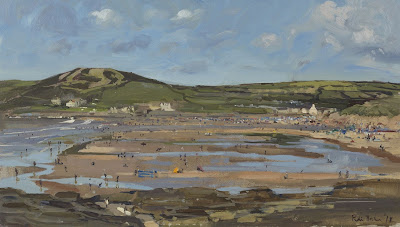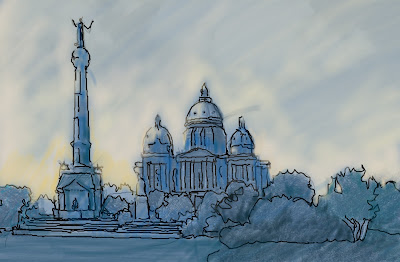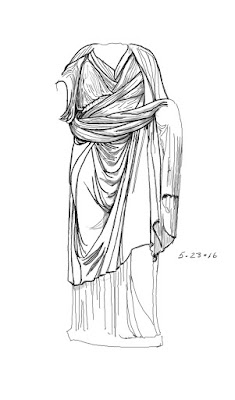Over the years I've had a number of teachers and mentors who have made a big impact on my work. Their kindness, funds of knowledge, and helpfulness are beyond price. Although I didn't know him, Irwin Greenberg was well-known to thousands who studied with him over the years at the High School of Art & Design and the
Art Students League of New York. I had the pleasure of meeting his best friend,
Max Ginsburg, a few years ago at a workshop in upstate New York, hosted by
Garin Baker at his Carriage House Studio. During the workshop, Max reminisced about his years teaching with "Greeny" at both institutions. Although he passed away in 2009, he remains a formidable presence in the lives of his myriad students.
 |
| Irwin Greenberg (image downloaded from http://artinabusyworld.blogspot.com/) |
During one of our conversations at the workshop Max mentioned a collection of sayings Mr. Greenberg posted in his teaching studio and had given to many of their students. Garin (who studied under both men) kindly unearthed his copy. They've likely been posted elsewhere on the Internet, but they're worth putting up again. Here they are.
---
Greeny’s Hundred
Irwin Greenberg’s Sayings about Art
1. Paint every day.
2. Paint until you feel physical strain--take a break and then paint some more.
3. Suggest.
4. When at an impasse, look at the work of masters.
5. Buy the best materials you can afford.
6. Let your enthusiasm show.
7. Find the way to support yourself.
8. Be your own toughest critic.
9. Develop a sense of humor about yourself
10. Develop the habit of work. Start early every day. When you take a break, don't eat. Instead, drink a glass of water.
11. Don't settle for yourself at your mediocre
level
12. Don't allow yourself to be crushed by
failure. Rembrandt had failures. Success grows from failure.
13. Be a brother (or sister) to all struggling artists.
14. Keep it simple.
15. Know your art equipment and take care of it.
16. Have a set of materials ready wherever you go.
17. Always be on time for work, class and appointments.
18. Meet deadlines. Be better than your word.
19. Find a mate who is really a mate.
20. Don't be envious of anyone who is more
talented than you. Be the best you can be.
21. Prizes are nice, but the real competition is with your performance
yesterday.
22. Give yourself room to fail and fight like hell to achieve.
23. Go to sleep thinking about what you're
going to do first thing tomorrow.
24. Analyze the work of great painters. Study how they emphasize and
subordinate.
25. Find out the fewest material things you need to live.
26. Remember: Michelangelo was once a helpless baby. Great works are the result
of heroic struggle.
27. There are no worthwhile tricks in art; find the answer.
28. Throw yourself into each painting heart and soul.
29. Commit yourself to a life in art.
30. No struggle, no progress.
31. Do rather than don't
32. Don't say "I haven't the time." You have as much time everyday as the great masters.
33. Read. Be conversant with the great ideas.
34. No matter what you do for a living, nurture your art.
35. Ask. Be hungry to learn.
36. You are always the student in a one-person art school. You are also the
teacher of that class.
37. Find the artists who are on your wavelength and constantly increase that
list.
38. Take pride in your work.
39. Take pride in yourself.
40. No one is a better authority on your feelings than you are.
41. When painting, always keep in mind what your picture is about.
42. Be organized.
43. When you're in trouble, study the lives
of those who've done great things.
44. "Poor me" is no help at all.
45. Look for what you can learn from the great painters, not what's wrong with them.
46. Look. Really look.
47. Overcome errors in observing by exaggerating the opposite.
48. Critics are painters who flunked out.
49. Stay away from put-down artists.
50. If you're at a loss for what to do
next, do a self-portrait.
51. Never say "I can't." It closes the door to potential development.
52. Be ingenious. Howard Pyle got his start in illustrating by illustrating his
own stories.
53. All doors open to a hard push.
54. If art is hard, it is because you're struggling to go beyond what you know you can do.
55. Draw everywhere and all the time. An artist is a sketchbook with a person
attached.
56. There is art in any endeavor done well.
57. If you've been able to put a personal
response into your work, others will feel it and they will be your audience.
58. Money is OK, but it isn't what
life is about.
59. Spend less than you earn.
60. Be modest; be self-critical, but aim for the highest.
61. Don't hoard your knowledge, share it.
62. Try things against your grain to find out just what your grain really is.
63. Inspiration doesn't come when you are idle. It
comes when you have steeped yourself in work.
64. Habit is more powerful than will. If you get in the habit of painting every
day, nothing will keep you from painting.
65. There are three ways to learn art: Study life, people and nature. Study the
great painters. Paint.
66. Remember, Rembrandt wasn't perfect.
He had to fight mediocrity.
67. Don't call yourself an artist. Let others
name you that. "Artist"
is a title of great weight.
68. Be humble; learn from everybody.
69. Paintings that you work hardest at are the ones you learn the most from,
and are often your favorites.
70. Read values relatively. Find the lightest light and compare all other light
values to it. Do the same with the darks.
71. Grit and guts are the magic ingredients to your success.
72. Let your picture welcome the viewer.
73. Add new painters to your list of favorites all the time.
74. Study artists who are dealing with the same problems that you're trying to solve.
75. Have a positive mind-set when showing your work to galleries.
76. Don't look for gimmicks to give your work
style. You might be stuck with them for life. Or, worse yet, you might have to
change your style
every few years.
77. If what you have to say is from your deepest feelings, you'll find an audience that responds.
78. Try to end a day's work on a picture knowing how
to proceed the next day.
79. Don't envy others success. Be
generous-spirited and congratulate whole-heartedly.
80. Your own standards have to be higher and more scrupulous than those of
critics.
81. Pyle said, "Throw your heart into a picture
and jump in after it."
82. Vermeer found a life's work in the corner of a room.
83. Rembrandt is always clear about what is most important in a picture.
84. If, after study, the work of an artist remains obscure, the fault may not
be yours.
85. Critics don't matter. Who cares about
Michelangelo's critics?
86. Structure your day so you have time for painting, reading, exercising and
resting.
87. Aim high, beyond your capacity.
88. Try not to finish too fast.
89. The theory of the '€œlast inch'€ holds that as you approach the end of a painting, you must
gather all your resources for the finish.
90. Build your painting solidly, working from big planes to small.
91. See the planes of light as shapes, the planes of shadows as shapes. Squint
your eyes and find the big, fluent shapes.
92. Notice how, in a portrait, Rembrandt reduces the modeling of clothes to the
essentials, emphasizing the head and the hands.
93. For all his artistic skills, what's most
important about Rembrandt is his deep compassion.
94. To emphasize something means that the other parts of a picture must be
muted.
95. When painting outdoors, sit on your hands and look before starting.
96. Composing a picture, do many thumbnails, rejecting the obvious ones.
97. Study how Rembrandt creates flow of tone.
98. If you teach, teach the individual. Find out when he or she is having
trouble and help at that point.
99. Painting is a practical art, using real materials--paints, brushes,
canvas, paper. Part of the practicality of it is earning a living in art.
100. Finally, don't be an art snob. Most painters
I know teach, do illustrations, or work in an art-related field. Survival is
the game.























